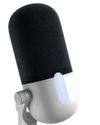Fans are simple enough, right? Not quite. There are a few things you need to learn before you can pick with confidence.

Pass Electricity through a conductor, and it gets hot. All the little electrons bump into things and transfer energy. This bit of basic physics is useful for an electric fire, but a real annoyance for your silicon, which needs to be kept cool. Back in the day, the only fan you might have had on a computer was in the power supply, blowing hot air out. The Intel 486 was the first processor to need a fan of its own, on the faster versions anyway. The original Pentium could just about manage on passive cooling in its slower incarnations, but was likely to pop under load if you weren’t careful (no universal fail-safe thermal cut-offs back then—if you overheated it, you may well have killed it). Since then, every chip has needed dedicated cooling. Graphics cards soon started to get too hot to run unaided, too. The fans got bigger, and spread. Now, some motherboard chipsets, drives, and even memory modules sport fans. And case fans have proliferated into banks of spinning LED lights all over the case.
If you run an unmodified rig, the fans it came with will work well enough, albeit too noisily for comfort. If nothing else, a good fan is quieter. If you start upgrading and over clocking, adequate cooling is imperative—time to add new fans. At least they’re simple. Actually, like every aspect of PCs, fans have their own specifications and variations in design and function, so there are a few things it would be useful to know first. Although getting the “right” number and position is still something of a dark art.
The Specifications
Bu hikaye Maximum PC dergisinin May 2017 sayısından alınmıştır.
Start your 7-day Magzter GOLD free trial to access thousands of curated premium stories, and 9,000+ magazines and newspapers.
Already a subscriber ? Giriş Yap
Bu hikaye Maximum PC dergisinin May 2017 sayısından alınmıştır.
Start your 7-day Magzter GOLD free trial to access thousands of curated premium stories, and 9,000+ magazines and newspapers.
Already a subscriber? Giriş Yap

Google Gemini vs. ChatGPT
Which LLM currently holds the crown?

Frostpunk 2
Endure a blizzard of tough choices and lasting consequences in the survival city builder sequel

Elgato Facecam Neo
Always sees us in the best light but lacks focus: 8/10 boyfriend, er, camera

Elgato Wave Neo
The Kanye West of mics: Easy to get into, but a little weird

Razer BlackWidow V4 75%
Solid and compact, with hot-swappable switches

Razer Wolverine V3 Pro
Razer's pro controller is even better than Microsoft's

Acer Predator GM712
2008 called, it wants its projector back

AndaSeat Kaiser 4 XL
A chair as big and as comfortable as they come

Gigabyte F027Q2
Speed is of the essence with this OLED screen

Acer Nitro 14
AMD puts on a good show, but it still lacks punch